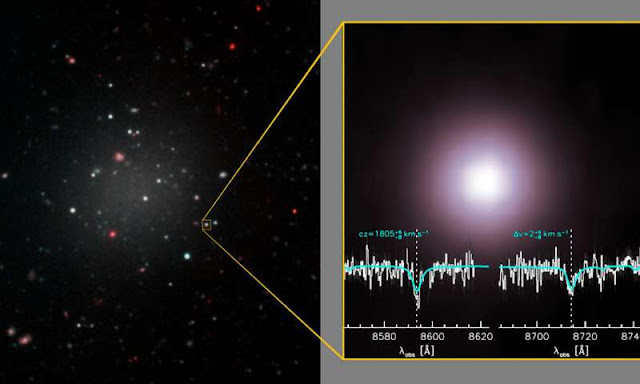A descoberta que existe a chamada "matéria escura" não é recente. Observações astronômicas indicavam que a massa total de uma galáxia não podia ser explicada somente pela matéria observável (estrelas, gases e poeira), mas que deveria existir alguma coisa a mais. O astrônomo suíço Fritz Zwicky (ver aqui) foi o primeiro a registrar essa ideia em um artigo (1937), chamando essa matéria não visível de "dunkle Materie" (Zwicky, F. (1937), «On the Masses of Nebulae and of Clusters of Nebulae», Astrophysical Journal, 86, Bibcode:1937ApJ....86..217Z, doi:10.1086/143864). Então, a ideia de que a matéria escura está sempre presente na formação e manutenção de galáxias é um consenso. Aí vem um novo artigo e mostra que essa ideia não é inteiramente correta. O abstratc do artigo ("Letter" - Nature volume 555, pages 629–632 (29 March 2018); doi:10.1038/nature25767):
A galaxy lacking dark matter
Studies of galaxy surveys in the context of the cold dark matter paradigm have shown that the mass of the dark matter halo and the total stellar mass are coupled through a function that varies smoothly with mass. Their average ratio Mhalo/Mstars has a minimum of about 30 for galaxies with stellar masses near that of the Milky Way (approximately $5 \times 10^{10}$ solar masses) and increases both towards lower masses and towards higher masses. The scatter in this relation is not well known; it is generally thought to be less than a factor of two for massive galaxies but much larger for dwarf galaxies. Here we report the radial velocities of ten luminous globular-cluster-like objects in the ultra-diffuse galaxy5 NGC1052–DF2, which has a stellar mass of approximately $2 \times 10^8$ solar masses. We infer that its velocity dispersion is less than 10.5 kilometres per second with 90 per cent confidence, and we determine from this that its total mass within a radius of 7.6 kiloparsecs is less than $3.4 \times 10^8$ solar masses. This implies that the ratio Mhalo/Mstars is of order unity (and consistent with zero), a factor of at least 400 lower than expected. NGC1052–DF2 demonstrates that dark matter is not always coupled with baryonic matter on galactic scales.
Fonte: Nature - aqui. Uma notícia sobre o assunto aqui.


Nenhum comentário:
Postar um comentário